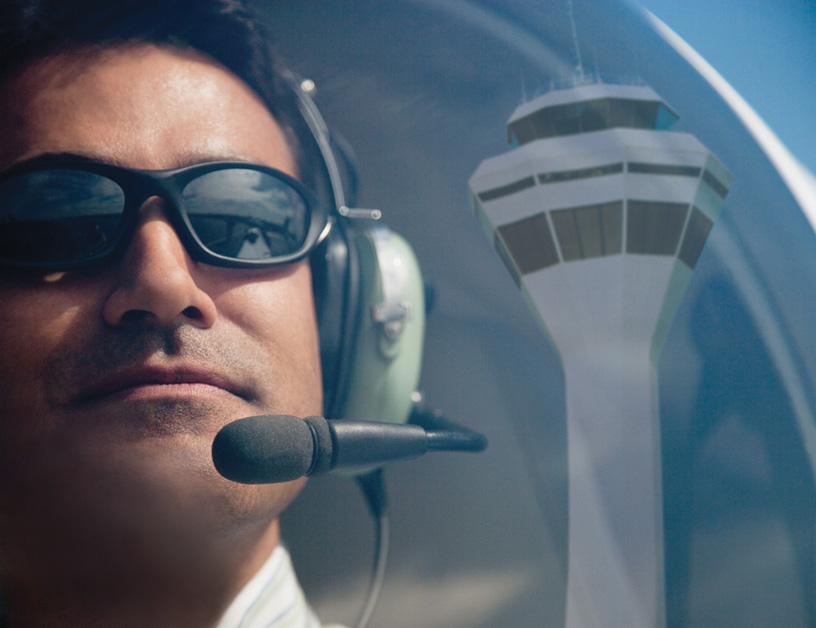Talking on an aviation radio and understanding air traffic control (ATC) instructions can be one of the most intimidating aspects of flight training. First-timers may find that mic fright is real. In Say Again, Please, Bob Gardner encourages pilots...
Talking on an aviation radio and understanding air traffic control (ATC) instructions can be one of the most intimidating aspects of flight training. First-timers may find that mic fright is real. In Say Again, Please, Bob Gardner encourages pilots to remember that they are a part of a team and that safety and clarity are more important than using the perfect turn of phrase when it’s time to keep those on the ground and in the air in the know. Read on to get Bob’s advice on joining the air safety lineup.
The Pilot-Controller Partnership for Safety
Aviation communication is a team effort, not a competition between pilots and controllers. Air traffic controllers are just as anxious as you are for your flight to be completed safely. They will cooperate with you whenever they can do so while still remaining consistent with safety. They are not the equivalent of the stereotypical law enforcement officer just waiting for you to do something wrong. They hate paperwork as much as anyone, and filing a violation against a pilot starts an avalanche of forms and reports. On the other hand, they have a tremendous amount of responsibility and can be severely overloaded with traffic, which means you can’t expect a controller to ignore everyone else to give you special treatment.
Inherent in the teamwork concept is equality. Yes—controllers can and will give you instructions that you must follow (unless it is unsafe to do so), but they are not aviation police with books of tickets just waiting for you to make a mistake. They are on your side. Like all of us, they have bad days, so don’t read too much into a controller’s tone of voice. And don’t ask for permission (i.e., do not use the word “permission”). That sets my teeth on edge. Instead just say, for example, “Request taxi instructions,” “Request 10 degrees left for weather,” “Request direct Bigtown Municipal,” and the like.
Many pilots are reluctant to use the radio because they feel they are imposing on the controller. They should put themselves in the controller’s seat: There are 20 targets on the scope and the controller knows the altitude, course, and intentions of 19 of them because they are on instrument flight plans or are receiving radar flight following services. For the 20th target, the controller knows only its altitude and present direction of flight (VFR flight plans are not seen by the air traffic control system). Will that target change altitude and/or course and create a conflict? There is no way for the controller to know, and thus the unknown target imposes a greater workload on the controller. Don’t be that target.
Some pilots worry about talking to air traffic control (ATC) because they “don’t want to bother the controller.” Controller’s pay levels are based in part on traffic count, so by failing to communicate you hit the controller in the pocketbook. They welcome your call.

. . .
Technobabble Not Spoken Here
Use plain English. “Tell me what you want me to do,” might not appear in [The Aeronautical Information Manual] AIM, but if it is necessary to use that phrase, it gets the job done. The following suggestion will be repeated later more than once, because it is important: Listen to your radio. Other airplanes will be talking to air traffic control (ATC), getting weather reports, or communicating with advisory services. The information they are receiving might be useful to you and make it unnecessary for you to make a transmission (or allow you to drastically shorten your transmission). Go to any small airport (one without a control tower) with a VHF receiver that covers the aviation frequencies and just monitor the airport’s Common Traffic Advisory Frequency (CTAF)— ask one of the local pilots if you aren’t sure what the CTAF for that airport is. You will hear a dozen airplanes reporting that they are landing or taking off on runway 14 (for example), and then a strange voice will come on the frequency and ask, “What runway is in use?” That pilot hasn’t learned to listen.
Note: Advisory Circular 90-66 contains instructions for communication at airports without control towers.
That VHF receiver is your best source of information on how to communicate as a pilot. Get a copy of the Chart Supplement U.S., which contains the Airport/Facility Directory (A/ FD) for your area, and look up the frequencies that are used by the local airports and air traffic control facilities. Look in the Chart Supplement Section 4 for Air Route Traffic Control Center (ARTCC) frequencies, then tune in and listen to how the airliners communicate when en route. You will hear lots of good examples and a few alarmingly bad examples. You may not be able to hear both ends of the communication unless you live within line-of-sight distance of the ground station’s antenna, but a visit to a local tower-controlled airport will eliminate that problem.
When you are surfing the web, spend some time at liveatc.net. You will be able to listen to controller–aircraft traffic at a number of facilities nationwide and internationally.
While you are at your computer, go to faa.gov/ and locate FAA Order 7110.65. (This can be done through the search feature or by selecting “Regulations” from the menu and then “Orders and Notices.”) This directive tells controllers what to say and how to say it, and they are required to follow its dictates. This is important to you because you will see that controller transmissions follow a fixed format for each situation; only things like headings, altitudes, and facility names change. With this in mind, you will know what to expect in each situation. However, if it becomes apparent to the controller that the approved phraseology is not getting through to you, the controller is free to use plain language. By the same token, you are free to say, “I don’t understand what you want me to do,” if that is the case. Most of this ATC order will not apply to you, but review it anyway, it is a treasure trove of information and an excellent reference.
No matter what your instructor says, you can’t say something “wrong” on the radio. Read AIM 4-2-1; in it, you will find this gem: “Since concise phraseology may not always be adequate, use whatever words are necessary to get your message across.” With experience, we all catch on to the lingo, but failure to use specific phraseology is not a big deal. The Airman Certification Standard for Private Pilot does require the applicant to use standard phraseology but a quick look at the AIM reveals that, while it tells you how to report headings, altitudes, and speeds and provides the phonetic alphabet for pronunciation of letters and numbers, there is not much required phraseology. Read Advisory Circular 90-66 as a better source of information for this.
Blown away by the whole idea of talking to controllers? Go to youtube.com/user/AirSafetyInstitute to get a controller’s take on it. There are several videos, and you should watch them all. Search “Ask ATC” and watch a playlist of pilots’ questions for controllers about communications.
Find the seventh edition of Say Again, Please at your favorite aviation supplier, or on ASA’s website here.
The post Remember Air Traffic Control Is on Your Team first appeared on Learn To Fly.















